
Topics
On the first anniversary of Hurricane Katrina we speak with Jed Horne, an editor at the New Orleans Times-Picayune and author of “Breach of Faith.” Horne says, “Louisiana is part of the old south…The mayor is a Democrat but could probably be called a neoconservative. He’s as much a believer in the kind of free market, less-is-more approach to government as Karl Rove, one of his mentors.” [includes rush transcript]
When Hurricane Katrina hit, the staff of New Orleans’ major newspaper “The Times Picayune” was forced to evacuate the building where the paper was housed. They set up operations in Baton Rouge but continued to publish daily and chronicle the unfolding catastrophe taking place in their city.
In its September 4th edition, the Times Picayune published a blistering open letter to President Bush criticizing him for the federal government’s response to Hurricane Katrina and calling for the firing of FEMA chief Michael Brown. The paper subsequently won two Pulitzer Prizes for its coverage of the disaster.
- Jed Horne, an editor at The Times-Picayune in New Orleans. He is the author of “Breach of Faith: Hurricane Katrina and the Near Death of a Great American City.”
Transcript
AMY GOODMAN: We’re joined right now by one of the editors of the Times-Picayune, Jed Horne. He wrote Breach of Faith: Hurricane Katrina and the Near Death of a Great American City, part of the team that won two Pulitzer Prizes for their coverage of the hurricane. The Times-Picayune, forced to evacuate the building where the paper was housed, set up operations in Baton Rouge, continued to publish daily and chronicle the unfolding catastrophe that was taking place in their city.
In its September 4th edition, the Times-Picayune published a blistering open letter to President Bush criticizing him for the federal government’s response to Hurricane Katrina, calling for the firing of FEMA chief Michael Brown. The paper subsequently, again, won those two Pulitzers. Jed Horne, welcome to Democracy Now!
JED HORNE: Thanks. It’s a pleasure to be with you, Amy.
AMY GOODMAN: It’s good to have you with us. You covered the catastrophe. You were a part of the catastrophe. Go back a year and tell us the personal story of you and the paper, and how you dealt with this.
JED HORNE: Well, I think the paper rallied as a team magnificently, and I can claim only a small part in that effort. I was also one of the very lucky ones, in the sense that my house did not flood, and so it was possible to turn that into a kind of a boarding house for all the folks whose houses — or not all of them, God knows, but some of them, whose houses had flooded. I found myself working with people who, you know, were essentially homeless people. And yet the effort to — the sense of urgency was only that much greater and galvanic in putting out those papers.
AMY GOODMAN: And so, you did it day after day. And as your city was shredded, you blistered the federal government. Were you surprised by the response of the government? How much did you and the paper, your community, New Orleans, understand as the hurricane was coming to town?
JED HORNE: We certainly understood the gravity of the situation, as the federal government should have. There had been, after all, the exercise called Hurricane Pam, which was a dress rehearsal for just this kind of event, in which as many as 60,000 deaths, if I recall, were anticipated in the mock-up. There’s no doubt that New Orleans is hurricane — is at risk for hurricanes.
The shocking thing was how complete and abject the failure of the federal response turned out to be, that it should take the better part of a week for the richest country in the world to get some buses a few miles into a flood plain, indeed into the parts of it that hadn’t even flooded, which were fully accessible as the media demonstrated day after day after day. For some reason, the feds couldn’t quite get that together. And that was different, because I’ll tell you the truth: here in the South, where we’re prone to a sense of federal oppression and federal meddling and this kind of omnipotent federal presence, it was startling to realize how completely incompetent the Bush administration was in this instance.
AMY GOODMAN: You begin your book by talking about Patrina Peters. Tell us about her story.
JED HORNE: Well, Patrina Peters was a remarkable figure for me. She was a resident of the Lower Ninth Ward, and she taught me a number of lessons. She’s one of those people — I think we all had a kind of helicopter’s eye view of this devastation as it first unfolded. We had seen people on the rooftops waving their arms around and desperate for help. In the course of trying to re-create these events, I wanted to get into the heads of those people and understand what it was like, as it was for Patrina, to be on the rooftop with her daughter clinging to them as the pieces of asbestos shingling flew by and as they begged for their lives from the Almighty and broke into hymns, to have that whole house lift up off the ground and be floated towards what they were certain was going to be their death.
I followed several lives like that through — sort of threading them through a narrative that lasts about eight months to a year, trying to understand the changes that this catastrophe brought and the decisions that they made in the aftermath of that storm’s strike. I was not interested exclusively in Patrina, although her story was fascinating.
She was exemplary of something a lot of people don’t realize about the Lower Ninth Ward, which was that many of those residents were homeowners. Many of them were self-sufficient. And interestingly, many of them chose to stay. There’s a hurricane culture here that causes people, for — out of just sheer stubbornness perhaps and also a sense of obligation to their property, to tough it out.
I spent time, as well, with Charmaine Neville, who had the exceedingly ghastly experience of staggering through floodwaters to safety, only then to be raped on a rooftop. I spent time with a guy named Earl Farrell, who fascinated me, because Earl was, by popular accounts, a crook. He was hijacking cars. He was looting stores for his girlfriend. He was also providing survival-level provision for his community. There’s a line that separates survivalism from wanton looting, and it was interesting to me to understand where that line lay.
I spent time with politicians. I spent time with media people, trying to understand where the obligation to participate in rescue missions ended and the professional responsibility to simply document the horror began. And all of that kind of verges on a chorus of lives, a thread, a braid of lives that show us kind of the grit and resolve that’s going to bring New Orleans back.
AMY GOODMAN: Jed, I wanted to ask you about the dead bodies. When we went down to New Orleans to cover the story, community organizer Malik Rahim, who is co-founder of the Common Ground Collective, took us to Algiers, showed us a dead body that had been there for days — actually for weeks.
MALIK RAHIM: Now, his body been here for almost two weeks. Two weeks tomorrow, alright, that this man’s body been laying here. And there’s no reason for it. Look where we at? I mean, it’s not flooded. There’s no reason for them to be — left that body right here like this. I mean, that’s just totally disrespect. You know? I mean, two weeks. Every day, we ask them about coming and pick it up. And they refuse to come and pick it up.
AMY GOODMAN: As Malik Rahim was speaking, as if on cue, every level of authority he mentioned drove by.
There’s a dead body right here. Is — who are you with?
SOLDIER: We’re with Bravo 15.
AMY GOODMAN: Which is?
SOLDIER: The cav.
AMY GOODMAN: Army?
SOLDIER: Army, yes. Regular army.
AMY GOODMAN: There’s a dead body right here. Can you guys pick it up?
SOLDIER: I don’t think we can pick it up, but we can call the local authorities to come pick it up.
AMY GOODMAN: There’s a dead body right here. Can Louisiana State Troopers, can you pick it up?
LOUISIANA STATE TROOPER: You need to talk to our public information officer, Ma’am.
AMY GOODMAN: It’s been here for two weeks. We filmed it last week, and gentleman over here said he has been trying to get it picked up for two weeks. And Louisiana State Troopers, the Police, the Army, no one has responded. We’re looking right over at it right there.
LOUISIANA STATE TROOPER: You need to talk to our public information officer
AMY GOODMAN: Do you know what they should do to get this body removed?
ROBERT GONZALEZ: I have no idea. I can’t tell you. I don’t know. There’s been several people over here looking at it.
NEW ORLEANS POLICE OFFICER: Our sector is this area here.
AMY GOODMAN: So, this is right in your sector.
NEW ORLEANS POLICE OFFICER: Yes.
AMY GOODMAN: So, that body is right in your sector.
NEW ORLEANS POLICE OFFICER: Yes.
AMY GOODMAN: So, what should happen then?
NEW ORLEANS POLICE OFFICER: Well, what I can do in my position is let — notify my chain of command and leave it up to them to make those bigger decisions. It would be out of my hands. I’m just a lower level position.
AMY GOODMAN: There’s this dead body over there. Would the Army take it out?
ARMY LIEUTENANT: No, that’s not really in our jurisdiction. We can’t do any type of police work. So that’s not for us to handle. We can only report it and hope that the cops take care of it. But we can’t do anything.
AMY GOODMAN: You New Orleans Police?
NEW ORLEANS POLICE OFFICER: Yes, ma’am. I can’t talk, though.
AMY GOODMAN: We’re just — there’s a dead body over here, and we’re wonder if the police would pick it up.
NEW ORLEANS POLICE OFFICER: I have no comment on that, Ma’am. You’re going to have to call one of the press guys. Sorry.
AMY GOODMAN: Democracy Now! in New Orleans a year ago. Jed Horne, FEMA said that the media was not to show dead bodies. Your response?
JED HORNE: Well, the media had an obligation to show dead bodies and fortunately defied FEMA and did just that. You’re looking at an instance of bureaucracy in all of its stumblebum absurdity at work there. The body that Malik drew your attention to was one of, of course, hundreds of bodies that sat there for weeks, if not months, on end, in fact. I promise you that as they pull down the last of the houses that simply cannot be salvaged, they will find additional bodies under the rubble. That’s been happening as recently as a month or two ago.
I spoke at length with a guy named Gregory Richardson, who figures prominently in Breach of Faith as a guy of means, a wealthy man, self-made, a product of the Lower Ninth Ward who went on to put together a real estate empire, and he realized as he swam away from his home, snakes coiling around his legs, that that entire real estate holding was underwater, just as his own home was. He went down into the Lower Ninth Ward, the house where he had grown up, and found his own father dead in the home, called, of course, the authorities. There’s meant to be a protocol for handling a corpse. There was no doubt who this man was. His son was able to identify him. His own identification papers were on him. A month later, that body still lay in that house, as Mr. Richardson had the extreme misfortune to go back to the property, assuming long since that the body had been removed. There it was, by then bloated, putrified. And to cap it off, it was not until April — how may months is that? — six months later, that the federal authorities, having finally processed this rotted corpse, released it to the family for a decent and proper burial. If you don’t think that compounds the horror of something like Katrina, you got no soul at all.
AMY GOODMAN: Jed Horne, talk about the disparity in aid that has come to New Orleans versus what has gone to Mississippi.
JED HORNE: Well, there’s clearly a partisanship at play here, and there has been since the very first week of the storm. I think Louisiana, which suffered substantially more damage, initially was allocated only about half the per capita federal allocation of money for storm recovery. There’s been kicking and screaming, and some of that in balance has been rectified.
Obviously, Mississippi, under Governor Barber’s administration, is an administration very pleasing to the White House. Barber has been prominent part of the Republican establishment for some time. Louisiana is a vestige of the old South. I suppose you could say we have still Democrats in statewide office. We have a Democratic governor. She would not be considered a liberal by any standard. Outside of the South, she’s a centrist. The Mayor is a Democrat but could properly be called, I think, a neoconservative. He’s as much a believer in the kind of free market, “less is more” approach to government as Karl Rove, one of his mentors.
But there was clearly an effort, as the Bush administration came under fire and began to look increasingly foolish and incompetent, to blame somebody. And as often as not, that blame was assigned by contrasting Louisiana with Mississippi and blaming Louisiana for the failures of what was after all a federal levee system and its collapse.
AMY GOODMAN: Jed, I just wanted to interrupt for a second. You said, the Mayor. You’re talking about Mayor Nagin, a protégé of Karl Rove?
JED HORNE: Well, a subscriber to the same philosophy and a man pleased to chat with Rove on occasion, when he has had contact with the White House.
AMY GOODMAN: And how has that affected the way New Orleans has dealt with or the government of New Orleans has dealt with this?
JED HORNE: Well, what Ray is about — and he’s a man I respect, I hasten to say. I think he may be the wrong man at the wrong time. He believes — he subscribes to the philosophy that market forces are the surest way to revive this economy. And that has invited, I fear, a kind of directionlessness. Two or three planning documents that, one of which importantly was put together by his own appointed blue ribbon committee, have been effectively scuttled by the Mayor, partly because of electoral politics. He had the misfortune to be up for re-election this past spring, and there were some tough calls that had to be made, and he was, I think, frankly, reluctant to make them and deferred on every instance to market forces, to the wisdom of the people and so on. Well, we are wise people, and the market is a powerful engine, but we also need, I think, guidance through this kind of a mess.
I went over to Kobe, Japan last fall to understand how that city, comparable in size and comparable in its devastation in '95, after an earthquake, to what went on in New Orleans, had revived. And there, the differences were salient. There were some similarities, as well. But Kobe yielded, to strong direction from its mayor, a moratorium on immediate rebuilding, which throws people at risk of simply rebuilding what was devastated and what will be devastated again, and has come out of this with a spanking and successful revival. It's taken them a long time, and we need to bear that in mind. It’s going to take New Orleans a while. But there needs to be guidance. There needs to be a sense of purpose.
AMY GOODMAN: Finally, Jed Horne, your subtitle of Breach of Faith is Hurricane Katrina and the Near Death of a Great American City. Can you talk about how race has played into that and if you do hold out hope?
JED HORNE: I hold out great hope for New Orleans. New Orleans is an irrepressible force. The idea that you could not have a major city at the mouth of the continent’s most important waterway is preposterous. We’ve heard foolishness to that effect in Congress: we shouldn’t have a city there. Well, of course, you have to have a city there, and to speak of not rebuilding New Orleans, to have done other than throw everything at the rebuilding of New Orleans, including the category-five flood protections that we need, is decadent. This is a Republican administration that speaks proudly of its resistance to decadence. It is the height of decadence not to be rebuilding New Orleans to the state-of-the-art flood protection that it requires.
Race, New Orleans is a Black city. New Orleans will remain a Black city, one hopes. It is its character. It is its essence.
AMY GOODMAN: Yet, right now, we’re talking about a city that has changed in its complexion. It’s older, it’s whiter, it’s wealthier. What about that difference?
JED HORNE: Yes, but it remains a substantially Black city. It remains, as Mayor Nagin’s re-election attests, a majority Black city. And therein lies our hope for the sustenance of the culture that is so important to New Orleans, not just, I mean, as a tourist draw and as a part of our economy, but as what Wynton Marsalis has called the soul of America. I mean, if New Orleans is worth saving, it’s worth saving because of its culture, because of its music, because of its food. And all of that takes root in the Afro-American culture that has come our way from Africa, through Haiti and other ports of call, you know, in the Middle Passage, to this extraordinary place that we call New Orleans. It’s not going away. We will perhaps be inconvenienced and slowed by clumsy and stupid governmental response, but the grassroots level is back. It is vigorous, and it is irrepressible.
AMY GOODMAN: And the explanation of how, in this year, they haven’t made the levees be able to deal with a hurricane-five hurricane?
JED HORNE: Well, that’s not the work of a year. That’s the work of a long period of time, perhaps ten years. What is disgusting in this year is the reluctance, the failure to commit whole-hog and with adequate financing to that goal. The Army Corps itself, having finally acknowledged that its own designs were at fault and that this engineering catastrophe was its own doing, developed a road forward that would require and obligate the government to immediate preparation for category-five construction. The Bush administration stripped that language out of the Army Corps report, we’re told, and instead committed to a study of the possibility that we will someday have a category-five, as we call it, a state-of-the-art flood protection.
What’s needed right now is the commitment, because in a land that has an attention deficit disorder, New Orleans is going to be forgotten too quickly, and every politician knows that. Some perhaps are hoping for that. We need the federal commitment, the congressional commitment now to a long-term financing scheme for the construction of a state-of-the-art flood defense. Governor Blanco sees one in offshore oil revenues finally being allocated to Louisiana on a regular basis, with which we can finance our own state-of-the-art flood defense. We have to hope that that happens.
AMY GOODMAN: Jed Horne, thank you very much for being with us, an editor with the Times-Picayune in New Orleans. He won a Pulitzer Prize for his part in the Times-Picayune coverage of Hurricane Katrina. His book is called Breach of Faith: Hurricane Katrina and the Near Death of a Great American City, joining us from the studios of WLAE, also hit by Hurricane Katrina.

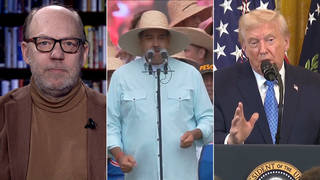
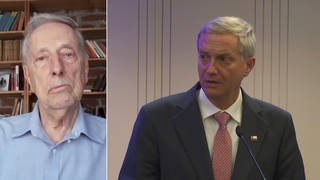
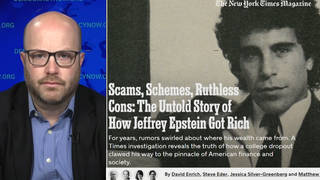

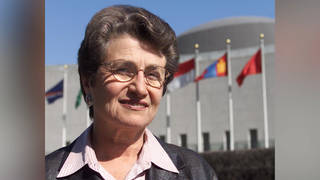




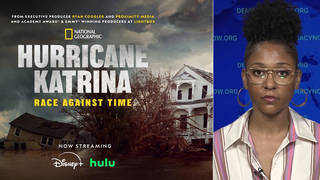

Media Options